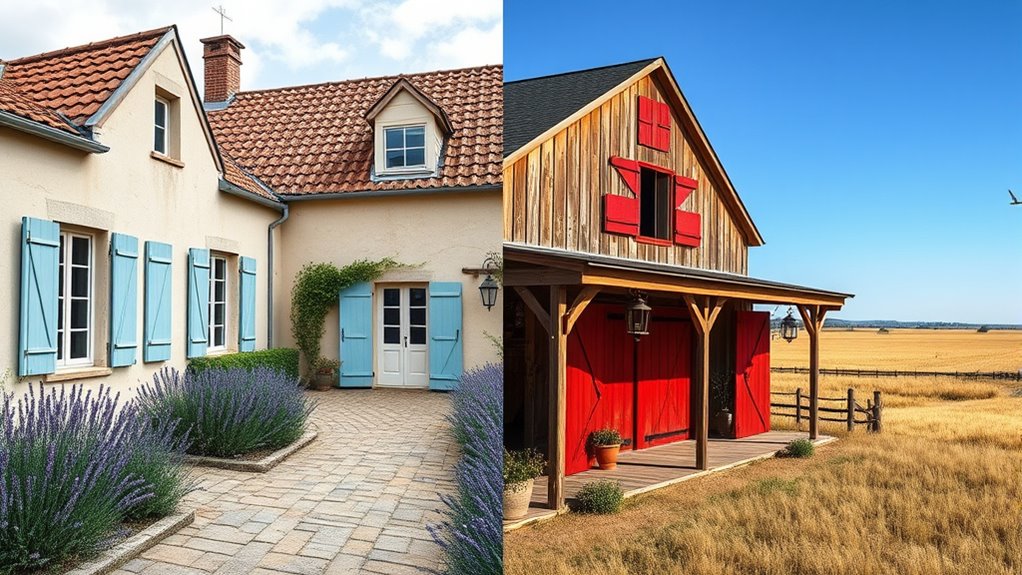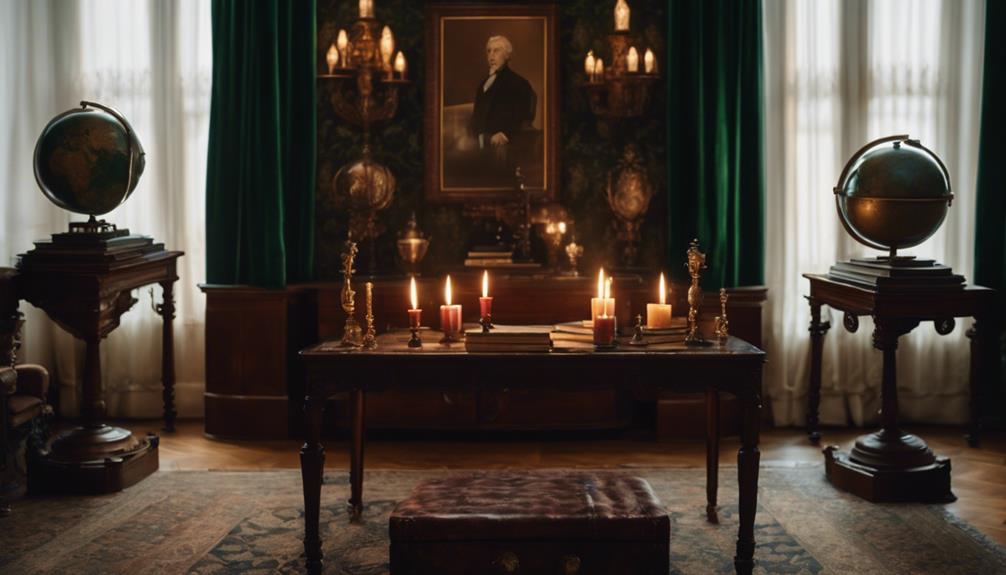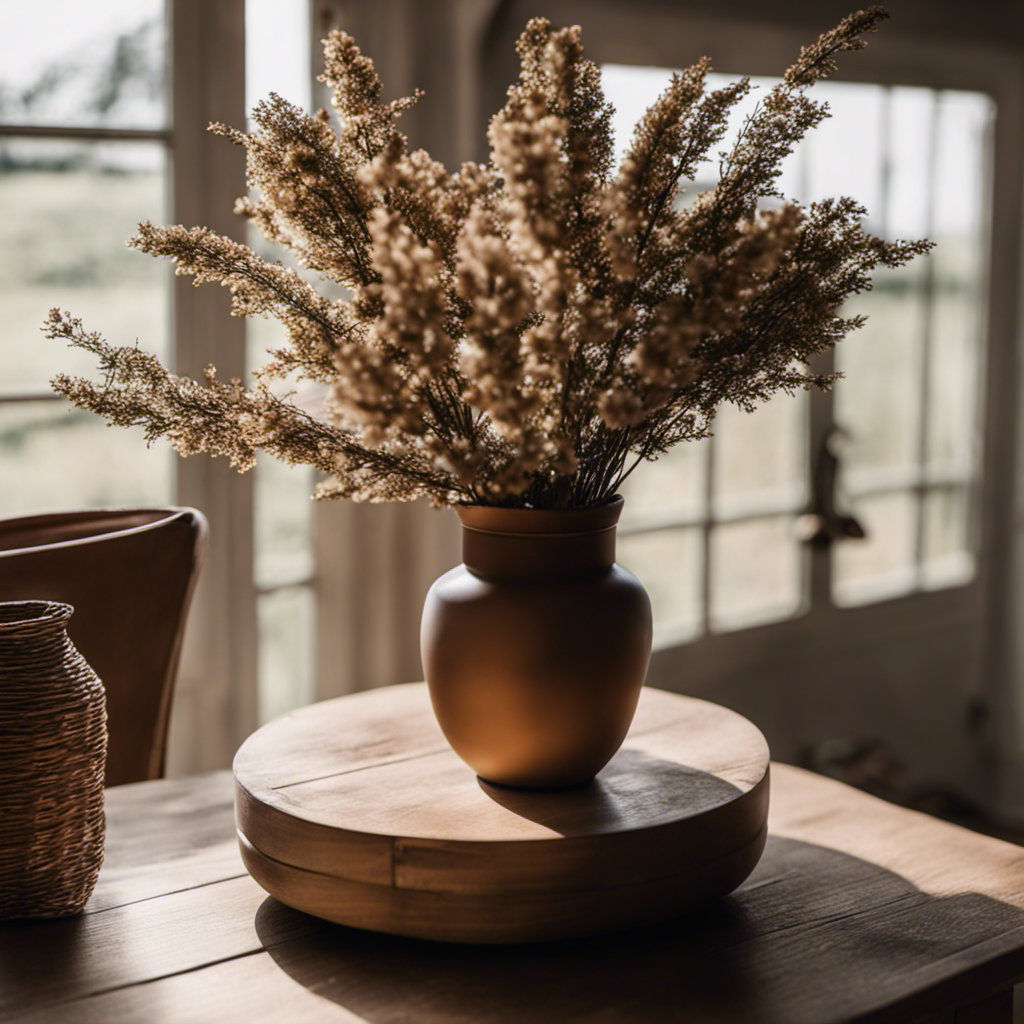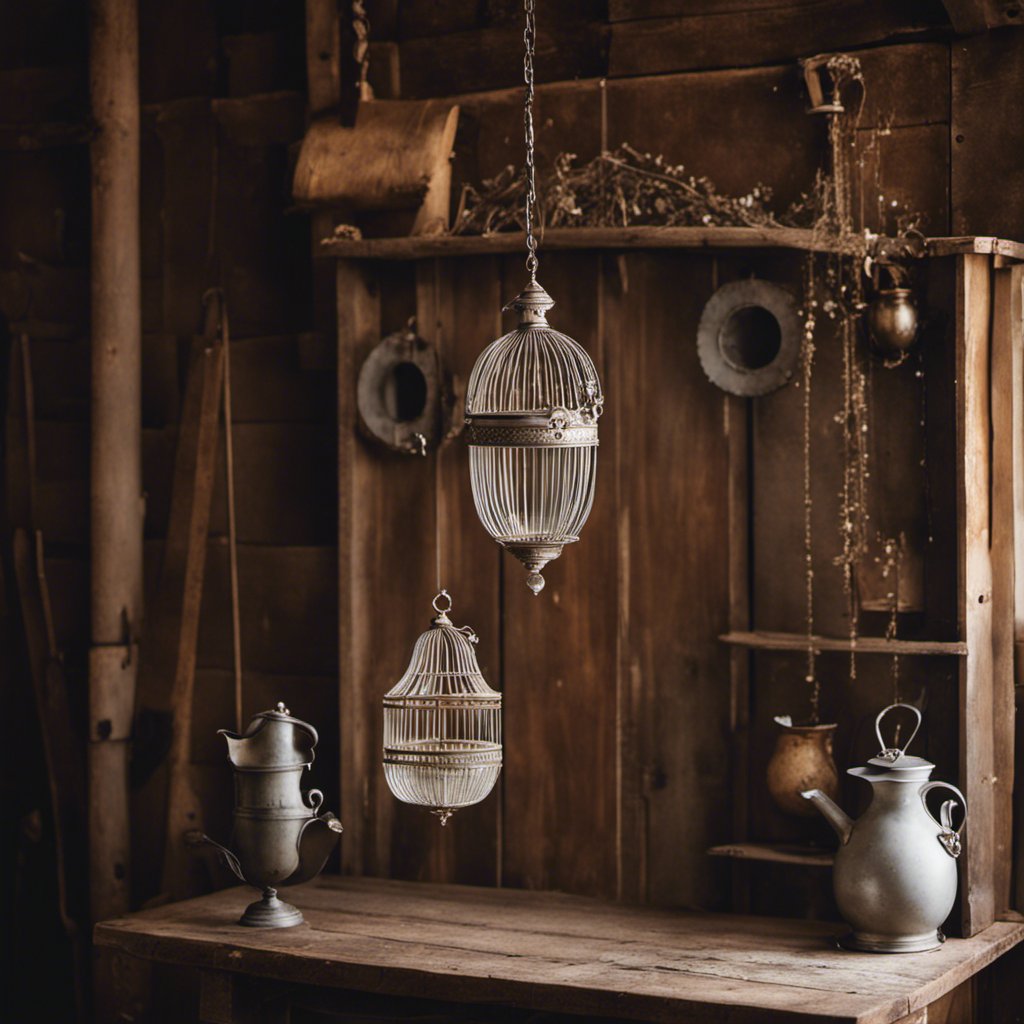When choosing between French Country and American Farmhouse styles, you might find yourself drawn to very different atmospheres. French Country offers elegance and ornate details, while Farmhouse emphasizes practicality and rustic charm. Understanding their origins, materials, and overall vibe can help you decide which aligns best with your home. There’s more to each style than meets the eye, and exploring these differences can guide your next design decision.
Key Takeaways
- French Country emphasizes ornate, vintage textiles, textured stucco walls, and elegant wrought iron accents, while American Farmhouse focuses on rugged, distressed wood and practical design.
- Color palettes for French Country are soft and muted, whereas American Farmhouse features warm browns, beiges, and cozy neutrals.
- French Country often includes ornate finishes, layered decor, and symmetrical layouts; Farmhouse favors sturdy furniture, open spaces, and rustic accents.
- Materials like weathered wood and vintage textiles are key in French Country; reclaimed wood, shiplap, and barn-inspired elements define Farmhouse style.
- Both styles share warm, neutral tones and vintage accents but differ in ornamentation, textures, and overall atmosphere—elegant versus practical rural charm.
Origins and Historical Influences
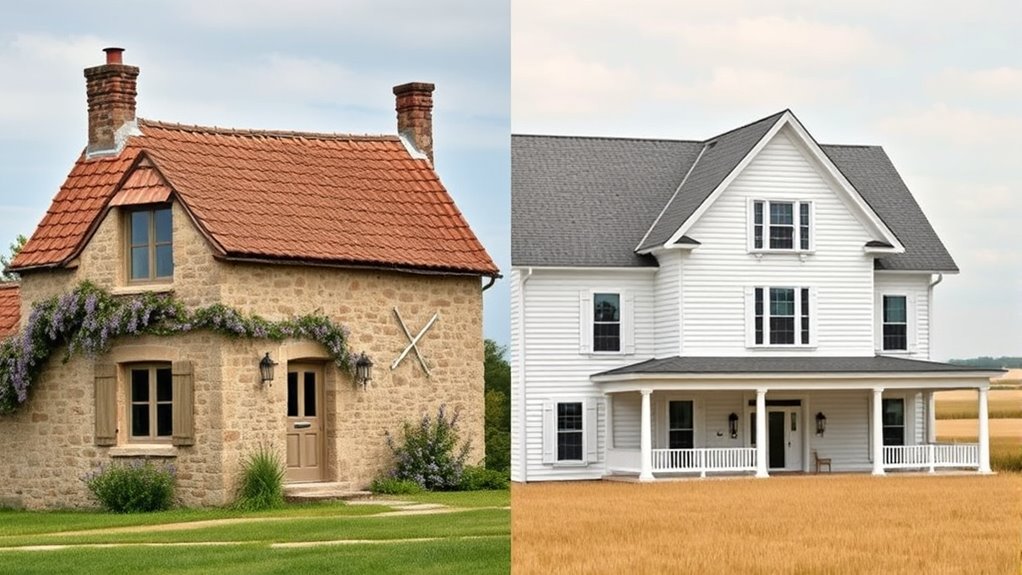
The origins of French Country and American Farmhouse styles are rooted in different cultural and historical contexts that shaped their distinctive looks. French Country style has rural origins tied to the Provence region, where simple, functional homes evolved over centuries, reflecting local traditions and climate. Its architectural evolution emphasizes rustic charm, natural materials, and a relaxed elegance. Both styles are rooted in rural communities but diverge in their historical influences, with French Country embracing regional elegance and American Farmhouse prioritizing practicality and durability. Additionally, the adaptation of these styles in modern architecture demonstrates the importance of cultural intelligence in understanding and respecting regional design elements and cultural significance.
Signature Design Elements and Materials
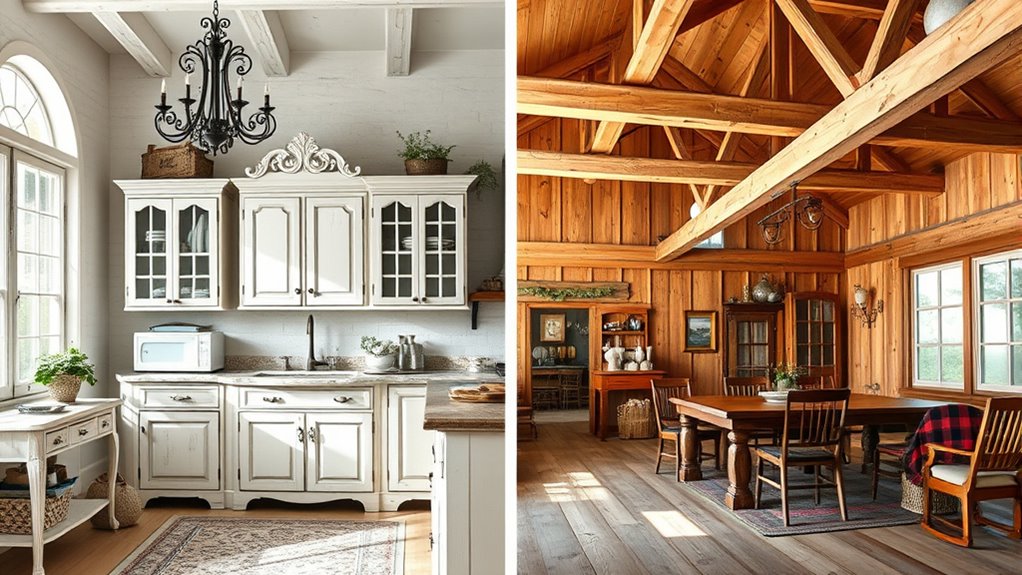
French Country and American Farmhouse styles each showcase distinctive design elements and materials that define their unique appearances. French Country emphasizes rustic charm through textured stucco walls, weathered wood furniture, and wrought iron accents. You’ll notice the use of vintage textiles like floral patterns and toile fabrics, adding a cozy, lived-in feel. Anime movies, with their diverse storytelling and artistic styles, often draw inspiration from these European and rustic aesthetics to create charming, nostalgic atmospheres.
American Farmhouse, on the other hand, features sturdy, reclaimed wood beams, shiplap walls, and simple, functional cabinetry. You’ll often find vintage textiles in the form of gingham or plaid tablecloths and curtains, enhancing the warm, welcoming atmosphere.
Both styles celebrate their heritage with authentic materials, but French Country leans more toward ornate details and soft finishes, while American Farmhouse champions practicality and rugged textures.
Color Palettes and Decorative Accents

Your color choices set the mood, with warm and neutral tones creating inviting spaces. Decorative accents like metal fixtures and wooden details add texture and character. Incorporating color palettes and decorative accents helps define whether you’re embracing French elegance or American farmhouse charm.
Color Warmth and Neutral Tones
While both French country and American farmhouse styles favor warm, neutral tones, they achieve different atmospheres through their color palettes and decorative accents. French country often incorporates soft, muted hues like creams, taupes, and gentle grays, creating an elegant, relaxed ambiance. Vintage textiles with delicate patterns and subtle textures add charm and enhance the warmth. Incorporating natural materials such as wood and linen further emphasizes the authentic, aged feel typical of both styles, while still maintaining their unique character. American farmhouse tends to favor richer, earthier neutrals such as warm browns, beiges, and grays, emphasizing coziness and practicality. Rustic lighting fixtures, like wrought iron chandeliers or lanterns, accentuate the inviting feel. These elements work together to craft spaces that feel both timeless and welcoming, with French country leaning toward refined softness, and farmhouse focusing on hearty comfort through their nuanced use of color and accents.
Decorative Metal and Wood Accents
Decorative metal and wood accents play a key role in defining the character of both French country and American farmhouse interiors. These elements add rustic charm and bring warmth to your space, whether through wrought iron light fixtures, distressed wooden beams, or vintage-inspired hardware.
In French country style, expect ornate metalwork and soft, weathered woods that evoke elegance with a touch of antiquity.
American farmhouses lean toward sturdier, more straightforward wood accents paired with rustic metal finishes for a cozy yet modern feel.
Combining these materials allows you to create a balanced look that blends rustic charm with modern elegance. Whether you prefer intricate iron details or rough-hewn wooden accents, these touches elevate your decor and reflect a timeless, welcoming aesthetic.
Furniture Styles and Layouts
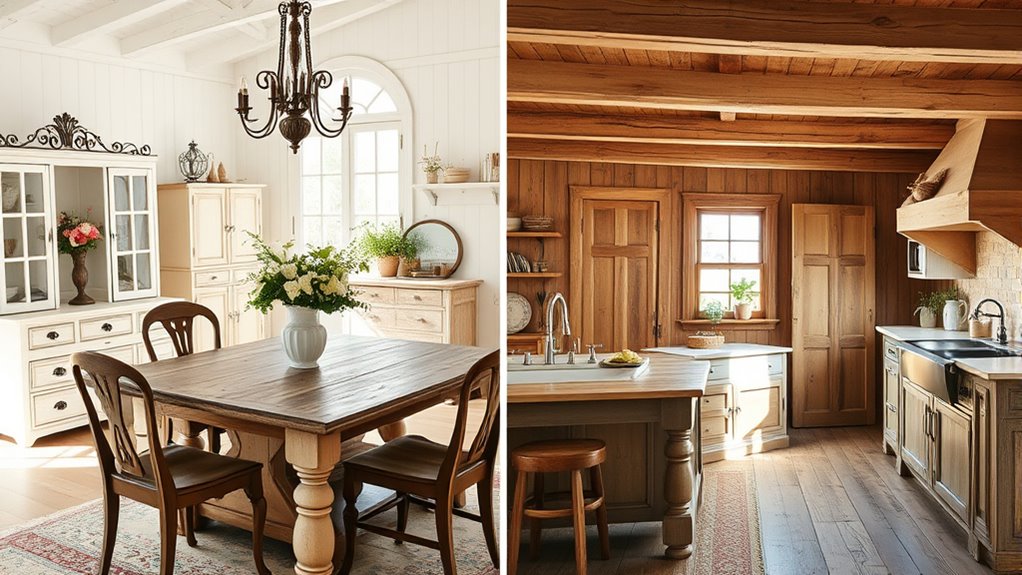
Your furniture choices reveal a lot about each style, from rustic wood in American farmhouses to ornate finishes in French country pieces. Notice how layouts emphasize symmetry and flow differently, creating distinct atmospheres. Incorporating self watering plant pots into these spaces can enhance natural elements and improve plant care with their consistent moisture delivery. Small decorative accents and intricate details further define the charm and personality of each design.
Furniture Material Choices
Furniture material choices play an essential role in defining the overall look and feel of both French country and American farmhouse styles. Your selection impacts the warmth, texture, and authenticity of your space. For dining room furniture, consider rustic woods like oak or pine for a cozy, inviting vibe. Bedroom furnishings often feature distressed or painted finishes on solid wood or reclaimed materials, emphasizing charm and durability. Popular options include: – Weathered oak or pine for rustic charm – Wrought iron accents for a vintage touch – Distressed or painted wood for a shabby chic look – Natural linen or cotton upholstery – Reclaimed wood for eco-friendly appeal. Incorporating unique and wicked planters can also elevate your interior decor with creative plant display options, adding to the authentic ambiance of these styles. These choices help create a timeless, welcoming atmosphere aligned with each style’s character.
Layout Symmetry and Flow
Layout symmetry and flow shape how furniture arrangements craft the overall atmosphere of a space, influencing both functionality and aesthetic appeal. In a French Country style, you’ll notice a focus on symmetry balance, creating harmonious and balanced layouts that feel inviting and cozy. Incorporating natural signs like cloud formations and animal behavior can also help inform how you design your space to reflect seasonal or weather patterns. American Farmhouse designs often prioritize open spatial flow, allowing for easy movement and a relaxed vibe. When arranging furniture, consider how symmetry can anchor a room, with matching pieces or mirrored layouts enhancing visual stability. Conversely, emphasizing spatial flow encourages a more casual, effortless feel, with furniture placed to facilitate gathering and movement. Whether you prefer the formal balance of French Country or the open simplicity of American Farmhouse, understanding how layout symmetry and flow work helps you craft a space that feels both beautiful and functional.
Decorative Accents and Details
Decorative accents and details play a crucial role in defining the character of a space, especially when it comes to furniture styles and layouts. They add personality and warmth, making your home feel inviting.
In French Country design, look for vintage textiles with floral patterns and soft colors, along with handcrafted pottery displayed on open shelves.
American Farmhouse style favors rustic accents like distressed wood furniture and woven textiles.
To enhance your space, consider incorporating:
- Vintage textiles for curtains or throws
- Handcrafted pottery as decorative accents
- Antique mirrors and framed artwork
- Wicker or rattan baskets for storage
- Rustic metal or wood lighting fixtures
These elements help create a layered, cozy feel that reflects the charm and history of each style. Additionally, incorporating vetted electric bike conversion kits can add a modern touch to your home’s aesthetic through integrated smart features or outdoor lighting solutions.
Practicality and Functionality in Living Spaces
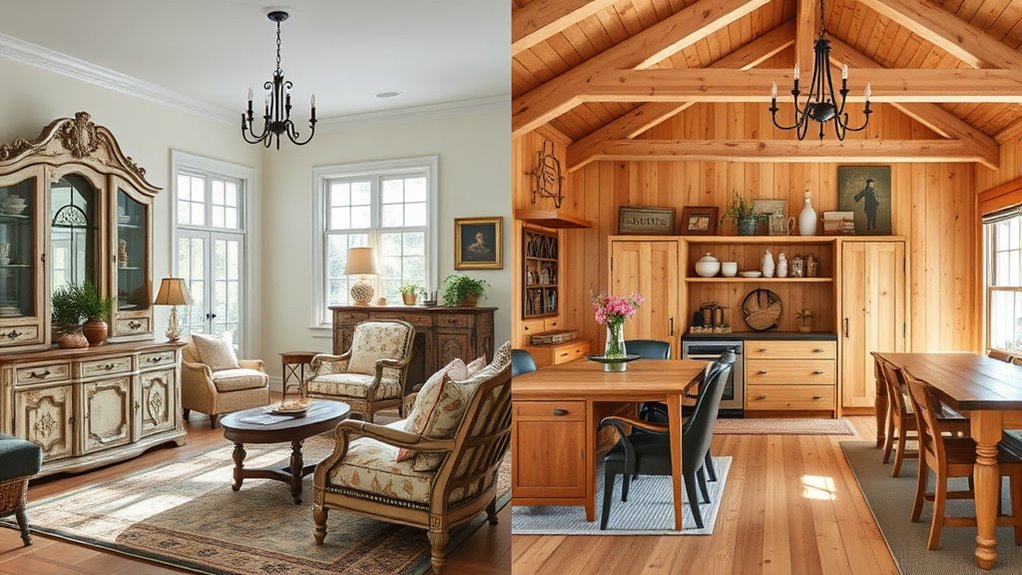
While both French country and American farmhouse styles emphasize charm and comfort, they approach practicality differently. In French country interiors, appliance placement tends to blend seamlessly with decor, often hidden behind cabinetry or decorative panels, maintaining a cozy aesthetic. Additionally, the use of storage solutions like antique chests, open shelving, and built-ins not only adds charm but also keeps essentials accessible. American farmhouse designs prioritize functionality, with large, open kitchens featuring central islands and ample cabinetry for easy appliance placement. You’ll find practical storage solutions like pegboards, open shelving, and spacious pantries that support an active lifestyle. Both styles value practicality, but French country leans toward subtle integration, while American farmhouse emphasizes accessibility and efficient use of space.
Tips for Incorporating Each Style Into Your Home
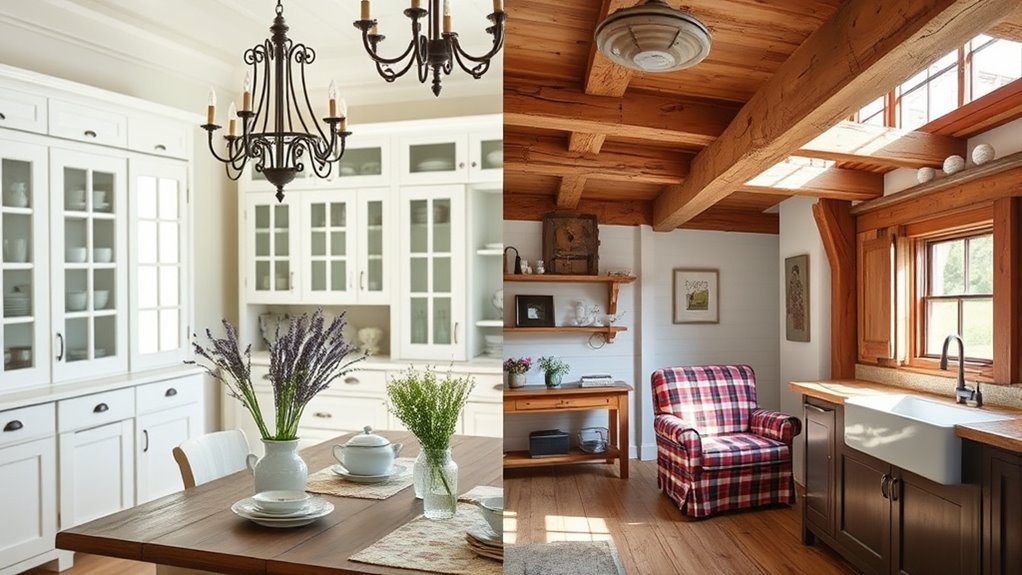
To successfully incorporate French country or American farmhouse style into your home, start by identifying key elements that define each look.
Identify key elements to seamlessly blend French country and American farmhouse styles into your home.
For French country, opt for soft, muted colors, ornate lighting, and elegant yet rustic decor.
For American farmhouse, focus on sturdy furniture, barn-inspired accents, and cozy, practical details.
To blend these styles seamlessly, consider updating your kitchen lighting with vintage pendant lights or lanterns that complement the overall aesthetic.
Enhance outdoor landscaping with rustic planters, stone pathways, or a vegetable garden to extend the farmhouse charm outside.
Here are some tips:
- Use warm, inviting kitchen lighting
- Incorporate natural materials like wood and stone
- Add vintage or distressed furniture
- Incorporate farmhouse furniture pieces to enhance authenticity
- Integrate outdoor landscaping with rustic elements
- Use textiles like linen and burlap for softness
Frequently Asked Questions
How Do These Styles Influence Outdoor and Garden Design?
You can create a mesmerizing outdoor aesthetic by choosing design elements that reflect your style. Incorporate garden charm with lush plants, charming pathways, and decorative details. Use rustic materials or elegant finishes to enhance the overall look.
Your outdoor space should invite relaxation and beauty, blending natural elements with curated touches that showcase your personality. This approach transforms your garden into a harmonious extension of your home’s unique charm.
Are There Specific Regions Where Each Style Is More Popular?
Imagine walking through a landscape where regional preferences and historical influences shape every detail. You’ll find French Country styles thriving in rural Provence, inspired by centuries of rustic elegance.
Conversely, American Farmhouse design is prominent in the Midwest, rooted in practicality and pioneer spirit. These regional preferences reflect deep historical influences, making each style distinct to its area.
How Do These Styles Adapt to Modern Technology and Smart Homes?
You can easily adapt these styles to modern technology by integrating smart home features seamlessly. Incorporate smart lighting, thermostats, and security systems that blend with the aesthetic. Use modern appliances that complement the rustic charm, ensuring they don’t disrupt the style’s warmth.
Embrace sleek, functional designs that enhance comfort and convenience, allowing you to enjoy the best of both worlds—timeless charm and cutting-edge smart home integration.
Can These Styles Be Combined Within a Single Space Effectively?
They say “the whole is greater than the sum of its parts,” and you can definitely blend styles effectively. With careful decor blending and style fusion, you create a space that feels both cohesive and unique.
Mixing elements of French Country’s elegance with American Farmhouse’s warmth adds character and charm. Just balance the rustic with the refined, and you’ll craft a harmonious environment that celebrates both styles seamlessly.
What Are Common Challenges When Renovating in These Styles?
When renovating in these styles, you might face challenges like renovation constraints that limit design choices and make it tricky to achieve your vision. Material sourcing can also be difficult, especially if you’re seeking authentic textures and finishes.
You’ll need to balance maintaining style integrity with budget restrictions. Sometimes, finding period-appropriate materials may take more time and effort, requiring patience and careful planning to guarantee a cohesive look.
Conclusion
Whether you’re drawn to the elegant charm of French Country or the cozy durability of American Farmhouse, embracing these styles can transform your home into a breathtaking retreat. With just a few carefully chosen pieces, you could turn your space into an oasis so stunning, it’ll leave visitors speechless—like stepping into a storybook. So go ahead, mix and match, and create a space that’s uniquely yours, full of warmth and timeless beauty.

